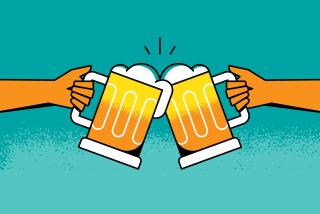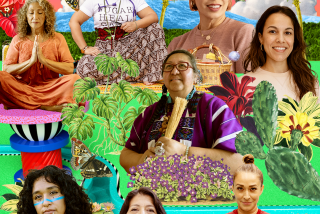‘The whole process of healing needs to be mediated by some third party.’ : Special Program Eases Therapy for Latino Burn Victims at UCI Center
Jesus, a mechanic, was severely burned on his hands, face and chest when a car’s gas tank exploded near him in mid-1985. Brought to the Burn Center at the UCI Medical Center for treatment, Jesus suffered from intense emotional and physical pain, according to Marlene Dobkin de Rios, a Cal State Fullerton anthropology professor who is a Burn Center consultant on relaxation and hypnosis exercises for Latino burn patients.
Jesus became part of an innovative, 4-year-old UCI program that seeks to provide what De Rios calls “culturally appropriate” treatment for Latinos.
The program was started because 20% to 30% of UCI’s burn patients are Latinos--a larger percentage than from any other minority group--and, according to hospital staff, these patients do not always respond well to treatments designed for the Anglo population.
Immediately after his accident, Jesus began having nightmares, losing sleep and suffering “flashbacks to the scene of the burn--he was reliving it again and again,” De Rios said.
Like many burn victims, Jose was suffering from “post-traumatic stress disorder,” said Joyce K. Friedmann, a licensed clinical psychologist and UCI assistant professor of psychiatry who is also chief of mental health services for the Burn Center.
The disorder, a psychological condition frequently experienced by war veterans, rape victims and others who undergo violent and painful experiences, can be cured through a combination of psychotherapy and “progressive desensitization” exercises--hypnotic procedures that emphasize relaxation and visualizing “a series of images relating to the original trauma . . . until there is no more reaction to it,” according to Friedmann, who is De Rios’ supervisor at the Burn Center. In many cases, “if you don’t take immediate (psychological) intervention” with accident victims, Friedmann said, their stress builds further, and “they don’t sleep as well, they hurt more, they don’t heal as quickly, they tend not to comply with medical treatment . . . . The patients withdraw from the system and they don’t get reintegrated back into their lives.”
Because too few American health professionals speak Spanish or understand Latinos’ cultural background, Friedmann said, it is often difficult for them--or members of other minority groups, as well--to get appropriate treatment when they are ill.
Relaxation and visualizing exercises are used with all UCI burn patients who show signs of post-traumatic stress disorder, Friedmann added, but De Rios conducts all her sessions in Spanish and has modified how she teaches the exercises to make the process more effective for Latinos.
Several full-time Burn Center employees speak Spanish. Translators are also available for burn victims who speak languages other than Spanish, and Friedmann said she is presently developing “culturally appropriate treatments” for Southeast Asian burn victims.
De Rios has a Ph.D. in medical anthropology--an academic discipline that she said is dedicated to studying “cross-cultural similarities and differences in healing.”
She also has taken more than 60 hours of training in hypnosis, and she belongs to the American Psychiatric Assn.’s psychological hypnosis division, as well as to the New York-based International Society of Clinical and Experimental Hypnosis.
No Psychotherapy
She does not conduct psychotherapy with the Latino burn victims, but instead uses hypnosis with patients like Jesus “directly to control pain and reduce stress,” she said.
While under hypnosis, Jesus was able to visualize himself successfully moving through social and work situations; he “eliminated his nightmares and flashbacks.”
Eventually he entered a private rehabilitation program and learned auto upholstery skills.
Before De Rios became a consultant, Burn Center staff were “mystified” that Latino patients they treated would “turn up for appointments--but they (often) wouldn’t go back to work” (unlike most of the center’s Anglo patients), even after their burn injuries healed, according to Dr. Bruce Achauer, a plastic surgeon who is the center’s director.
Traumatized by Accident
The Latino burn victims sometimes didn’t go back to work, De Rios said, because they were traumatized by their accidents--and the Burn Center’s program for helping victims of post-traumatic stress disorder was designed for mainstream Americans.
All the Latinos De Rios works with either speak Spanish only, or they are most comfortable speaking in Spanish. Almost always, she said, these Latinos “come from rural (Latin American) backgrounds, they’re not familiar with hospitals. They haven’t had a lot of experience with the ‘sick role,’ ” and they find the Burn Center’s modern medical equipment and treatment plans intimidating.
Often, she added, Latinos who were not raised in America have “a lot of problems with understanding what’s going on (during their treatment) . . . The whole process of healing needs to be mediated by some third party” like herself.
Now, say Friedmann and De Rios, most of those Latino patients who have completed enough sessions with De Rios are working and leading normal personal lives again.
Psychosocial Team
De Rios is part of a UCI “psychosocial team” that includes Friedmann, a social worker, consulting psychiatrists, a doctor of pharmacology, a “child life specialist” (who, Friedmann said, uses play therapy to reduce burned youngsters’ stress) and a marriage, family and child counselor.
The Burn Center also sponsors a “school re-entry program” that helps burned children regain peer acceptance and co-sponsors with the Orange County Burn Assn. a “burn recovery group” for adults.
Other members of the team work with burn victims daily, but De Rios, a full-time professor at Cal State Fullerton since 1969, visits the Burn Center only two days a week, where most of her work is with outpatients, she said. They frequently continue their once-a-week relaxation and hypnosis sessions for several months.
According to Friedmann, “poor and indigent” individuals often are served without charge, while more affluent burn victims pay for services.
Demographics of Victims
De Rios said most of the Latinos who seek treatment at the center were born in rural environments in Mexico or Latin America, live in “substandard housing” and work in low-paying restaurant jobs or in industrial jobs “related to the car culture, (where) the likeliness of (burning) accidents is high.”
During treatment, De Rios interacts with her clients in ways that she says conform to Latino cultural expectations. These include the idea that a woman--even a healer--”generally does not touch a male stranger,” she said.
Yet De Rios is awarded a certain status by young male Latinos because, she explained, she is 47 and “certainly old enough to be their mother. . . . The role of a helping older woman is appropriate” to Latino culture.
All her therapeutic interventions with Latinos are conducted in Spanish, De Rios said, because “feelings appear to be best expressed in the native tongue.”
Use of Metaphor
Once she has established rapport with a Latino burn victim, De Rios said, she explains what the clients can expect by using graphic “metaphor to try and talk about how (the client) is going to get better.”
For example, de Rios said, “I liken the process of (poor blood) circulation in the body to an irrigation canal that is muddied and not flowing properly.” She also often compares muscle function to car mechanics.
“Hypnosis is presented as an exercise to get back in control of the body” by cleaning up the “canals” and “discharging” excess energy from the patient’s “battery,” she said, and such metaphors stimulate communication with individuals whose formal education may have ended in the fourth or fifth grades.
Early in treatment, De Rios said, she has clients relax while she verbally “takes” them to some pleasant setting, like the beach or mountains. She tape-records this “journey,” and in later sessions she prepares other tapes to help a burn victim “positively visualize” himself or herself dealing concretely with difficult work and personal situations.
Given ‘Homework’
At the center, the burn victims learn how to use these tapes, then take them home for use once or twice a day.
Clients who stay with the program for 13 or 14 one-hour, weekly relaxation and hypnosis sessions and do their “homework” seem to benefit most, De Rios said.
Of 27 clients (from more than 50 burn victims she has worked with at UCI) whose progress De Rios charted over a 2 1/2-year period, “10 returned to work, three entered rehabilitation training to learn new skills, one is deceased, one retired, five dropped out of therapy (prematurely) and seven are still in treatment,” she said.
Returning to work is “the best treatment” for a burn victim, De Rios said. “They (the victims) agree, and you agree, so it’s really just a question of how they can function comfortably in a work environment. . . . Certainly in the Latino culture, there is a very strong work ethic.”
Too Seldom Used
Friedmann said she believes that relaxation training, self-hypnosis exercises and psychotherapy are too seldom used with burn patients in the nation’s approximately 200 burn centers.
At an early April convention of the American Burn Assn. in Chicago, Friedmann, De Rios and Achauer presented papers on how their program treats burn patients suffering from post-traumatic stress disorder.
Convention participant Dr. Frederick Stoddard, chief of psychiatry at the Massachusetts General Hospital-affiliated Shriners Burn Institute in Boston, confirmed in a telephone interview that the UCI Burn Center’s program is rare.
Stoddard said his own institute is unusual because it conducts many psychological interventions with Latino patients but added that “we don’t have the level of expertise in language and (medical) anthropology that they (the UCI workers) have.”
Published Two Books
Earlier, De Rios had established a reputation in the academic world through her field research into the customs of Peruvian folk healers. She wrote and published two books, “Hallucinogens: Cross-Cultural Perspective” and “Visionary Vine: Hallucinogenic Healing in the Peruvian Amazon.”
De Rios said she is finishing a third book, “Rectitude and Tears: A Profile of an Amazonian Drug Healer,” a biography of her Peruvian father-in-law, Don Hilde Rios. (De Rios has been married to Peruvian artist Yando Rios for 17 years.)
In 1974-75 De Rios and an Orange County doctor, the late Dr. Daniel Feldman, conducted a federally funded study of Mexican-American alcohol use in Southern California.
That study indicated that local Mexican-Americans are less likely than non-minority individuals to seek help from alcoholism-treatment agencies because such services are “not (physically) accessible and because there are not an adequate number of Spanish-speaking bicultural therapists available,” De Rios said.
Applying Knowledge
While De Rios said she didn’t pursue her alcoholism research beyond the initial study, she did think further about how local health services often don’t meet Latinos’ needs. The desire to do some “applied medical anthropology” later inspired her to take the consulting job at the Burn Center, she added.
Today her Burn Center work “is still very fresh to me,” De Rios said. In the future, she added, she’d like to “tour some of the burn centers in the country” to present, with Friedmann, information about how health professionals can best adapt their services to fit the needs of individuals from other cultures.
Disseminating such information might help “make health care delivery for the poor and disenfranchised a reality” in the United States, De Rios said.
More to Read
Sign up for Essential California
The most important California stories and recommendations in your inbox every morning.
You may occasionally receive promotional content from the Los Angeles Times.










